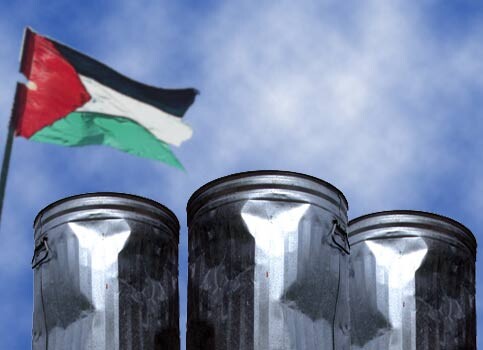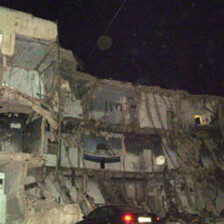Palestine Report 21 April 2005

(Graphic: EI)
At the beginning of April 2002, the Israeli army reoccupied a number of cities in the West Bank as part of a wide-scale military operation dubbed “Defensive Shield”. The goal of the operation, as stated by the Israeli government, was to “eliminate the infrastructure of Palestinian terrorism and to prevent suicide bombers from executing their operations in the heart of Israeli cities inside the Green Line.”
At the time, no attention was given to an artillery force that snuck up the hills to a quarry - the largest in the West Bank, which is located in the cradle of a huge hill west of Nablus. “We were shocked when we saw that the quarry was being taken over,” says the director of the quarry, Ihab Abu Shusheh. “The army ran us out and warned us not to return. They took over all of the equipment and our bulldozer. At the time, I wondered what the connection was between this raid and the declared goals of the army operation.”
“A few days later, we were told by residents from nearby villages that Israeli trucks were bringing in garbage and dumping it in the quarry. This continued for about a month. It stopped after we filed a complaint with the Israeli authorities in Beit El and to the Palestinian Authority. The trucks stopped coming for almost a year but then they started again.
“We renewed our complaints and the official work of these trucks was halted again. But they would come secretly, carrying tons of waste from the Kedumim settlement and Jewish industrial zones. They would dump them during the night in the quarry.”
Abu Shusheh, whose family has invested in the quarry for 20 years continues, “We complained to the Israel High Court, demanding that work be halted. We also demanded to be compensated for the damages incurred to the quarry. We even had the legal documents proving our ownership. But the court has not announced its verdict yet.”
Imposing reality
Work in the “dumpsite” continues, regardless of Abu Shusheh’s repeated complaints. Israeli machinery has cleared and prepared 10 dunams (4.5 hectares) of land from the quarry, which is about 100 dunams or 40.47 hectares altogether, according to a report issued by a commission of environmental and water experts from Al Najah University.
On April 4, the Israeli daily Haaretz then reported on an Israeli plan to turn the largest quarry in the West Bank into a dumpsite. According to the article, the contracting Israeli company already dumps 10,000 tons of garbage each month of waste from central Israel, even though the Israeli government has yet to approve the plan.
The Israeli foreign ministry later complained that most of the details in the Haaretz article were partial and misleading. However, a spokesperson for the ministry told Reuters on April 4 that the construction of the dumpsite “does not contradict with international law because it will be used for the benefit of the Palestinians and Israelis.”
Dr. Atef Abu Jeish from the Center for Water Studies at Al Najah University begs to differ.
“The establishment of the dumpsite is a blatant violation of international law and the Fourth Geneva Convention of 1949, which prohibits the occupying power from utilizing occupied territory in a way that does not benefit the occupied people. International law prohibits the occupying country of carrying out any works in occupied territory that are not a result of military considerations and are not used to the benefit of the local and occupied people.”
Restless residents
The area in which the dumpsite is being built is in an extension of the Ramin Valley, one of the most fertile and beautiful areas in the West Bank between Tulkarm and Nablus. The plans for the dumpsite, says Azzam Halaweh, director of the health department in the Nablus municipality, have naturally spurred much anxiety among people and government and non-government organizations given the negative and dangerous ramifications for both the population and the environment experts have identified.
“We have taken samples and inspected materials in the quarry,” Halaweh told the Palestine Report. “We found hard [organic] waste, mostly household garbage and some industrial waste, spread out over approximately 1.64 hectares [four dunams]. There are also swamps throughout the dumpsite, filled with liquid waste.”
There are four ground wells in close proximity to the dumpsite. In total, these wells, which are used for agricultural and household purposes, yield 750,000 cubic meters water per year. The wells provide water to thousands of area residents.
The most dangerous ramification of the dumpsite, according to the technical committee, is it is located only 230 meters from the Deir Sharaf aquifer, which provides Nablus with more than half its drinking water needs. The dumpsite is located on sedimentary soil, which is easily penetrable and means the possibility of contaminating the aquifer with fluids from waste products is extremely high. Gases and odors emanate from the dumpsite and insects and rodents are everywhere, marring the rural landscape.
In addition, residents of seven surrounding villages, with a combined population of over 25,000, fear the dumpsite will limit the available areas for their own construction. To them it all adds up to another crime perpetrated against them by Jewish settlers and to which the Israeli occupation authorities are turning a blind eye.
“The army occupied the land by military force,” says the head of Deir Sharaf village council, Najib Saha. “And under the protection of the army, the settlers build industrial zones. Then they do away with their waste on our land without the least regard for the risks to our health, our water or our environment. They collect taxes and go about their business like nothing is wrong. They force us to get rid of our garbage in distant areas while they come and throw their garbage at us. Why do they belittle us like this?”
Gunpoint investment
According to an internal document prepared by the Bar Onn company, which was reported on in Haaretz’s April 4 edition, the dumpsite will collect fees at a value of NIS60 per ton and will earn the settlement council of Hashmeron a profit of NIS60,000 a month.
The Bar Onn Company, the two settlement councils of Kedumim and Karni Shamron, as well as the regional settlement council, are currently preparing for the establishment of the dumpsite. Since November 2004, another Israeli company in Netanya has been transferring garbage to the quarry without obtaining a permit. A permit was granted only after hundreds of tons had already been dumped in the quarry. According to the Israeli media, Israel is planning to build three central dumpsites in Israel and 14 in the West Bank to get rid of their waste.
Stoking local ire even more is that while this is going on, Palestinians in the area have not been allowed a dumpsite of their own. According to Halaweh, the Nablus Municipality is burdened with huge financial expenses to get rid of its waste at a site in the Jordan Valley, some 45 kilometers from the city.
“They want to get rid of their garbage at our expense. Even if they were talking about building a perfumery, we would not accept,” said one villager in the area angrily.
A second wall
Saha from Deir Sharaf was also concerned about the closeness of the dumpsite to people’s homes.
“The closest house in our village is about 330 meters from the dumpsite. The other houses in Naqura, Sabastia, Qousin, Beit Iba and Kufr Qaddum are between 300 and 650 meters from it. There is a water basin that runs under the area of the dumpsite. I feel like the dumpsite is going to be a second wall. I would not be surprised if the separation wall included it, especially since there is a Jewish industrial zone built on the site.”
Officials from the Israeli water authority know these facts well. According to Haaretz, the official in charge of monitoring pollutants in the water authority wrote a document in June, 2004 entitled, “Water information and an initial viewpoint on throwing dry wastes in quarries,” including the Abu Shusha quarry.
“There is ground water in the quarry area at a depth of 250 meters. The quality of water is good. The Deir Sharaf wall extracts its water from there and is 620 meters from the location. The Nablus valley is 420 meters from the site. Given the close proximity of the wells to the site, it is deemed unsuitable to have a dumpsite there for fear of contamination of the water sources.”
Despite this, the settlement lobby has been able to circumvent these warnings from the water authority and create a reality on the ground, and the locals know it. “Daniel Vice, head of the Kedumim settlement and a member of the higher Jewish settlement council has come to the quarry and the area more than once,” said Saha.
Ongoing battle
According to agreements signed between the Palestinians and Israelis, the environment is supposed to be an area excluded from the conflict whether it’s a time of war or peace. In the case that either side carries out amendments or projects that will impact the environment, it should obtain the approval of the other side.
The fourth clause of the 12th article of Appendix 3 from the transitional agreement between Israel and the Palestinians signed in Washington on September 2, 1995 stipulates that, “each side must act towards the protection of the environment and to avoid any environmental hazards or damages including to all soil, water and airborne pollution.”
Environmentalists and farmers are not banking on Israel respecting this agreement. They say that to date Jewish settlements built in the heart of the West Bank such as Ariel and Karni Shamron, have not stopped pumping waste water from various industrial zones into the Qana valley, a practice that has been ongoing since 1982.
Engineer Sami Daoud from the Palestinian Hydrology Group said during a meeting of local activists that studied the ramifications of the dumpsite at which this reporter was present, that, “waste water has killed medicinal and wild plants in the valley. It has affected the biodiversity and the aesthetics of the area. Most importantly, the land is no longer fit to grow olive trees.”
Clause 6 of the first appendix of the interim agreement stipulates that, “each side must take the necessary and appropriate measures to prevent the leaking of waste water and liquid contaminants into water sources and networks or into water collection holes, including ground and surface water and rivers.”
Israel’s disregard for Palestinian needs in regards to the dumpsite at the Abu Shusha quarry is raising Palestinian suspicions of Israel’s ulterior motives. “I can’t see that Israel has any other goal in building this dumpsite on our land than wanting to drive us out,” says Najib Saha.
Dr. Azzam Halaweh believes that it is “another form of the Judaization of the West Bank.” He told PR that “mere talk of the land in question falling under Israeli control has sharply reduced the prices of land in the area and has negatively effected various agricultural, construction, and tourist projects in the area.”
Local organizations and authorities, in addition to international organizations and NGO’s, are planning to organize a campaign to stop the building of the dump. A number of delegations from various unions and professional organizations have visited the quarry site and held sit-in protests calling for the removal of the dump. They say they are in for the long haul.
Shaher Sa’ad, Head of the Federation of Workers’ Union, and the organizer of the campaign said, “the protests against the dump will continue in all non-violent forms.” Dr. Halaweh added. “Our struggle against the dump will continue until we succeed in removing it.”





